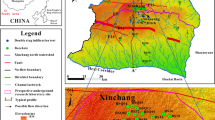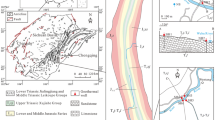Abstract
The formation mechanism of deep groundwater is a key issue for the safety assessment of the high-level radioactive waste repository. The circulation characteristics and age of deep groundwater at the Xinchang site were characterized. The results show that the permeability of the deep parts of the faults at the site is low and the scale is small. Deep groundwater did not undergo deep circulation. The 14C age of the deep groundwater was approximately 13.2 ka, and the deep groundwater circulation renewal rate was very slow. Therefore, the hydrogeological conditions at the site are beneficial to the selection of the site as a repository.









Similar content being viewed by others
References
Wang J, Chen L, Su R, Zhao X (2018) The Beishan underground research laboratory for geological disposal of high-level radioactive waste in China: planning, site selection, site characterization and in situ tests. J Rock Mech Geotech Eng 10(3):411–435. DOI: https://doi.org/10.1016/j.jrmge.2018.03.002
Hebig KH, Ito N, Scheytt T, Marui AJHJ (2012) Review: deep groundwater research with focus on Germany. Hydrogeol J 20(2):227–243. DOI: https://doi.org/10.1007/s10040-004-0429-y
Hubbert MK (1940) The theory of groundwater motion. J Geol 48. In: Anderson MP (eds) Benchmark papers in hydrology 3: groundwater. IAHS, Wallingford, UK. https://doi.org/10.1029/TR021I002P00648-1
Tóth J (1962) A theory of groundwater motion in small drainage basins in central Alberta, Canada. J Geophys Res 67(11):4375–4388. DOI: https://doi.org/10.1029/JZ067i011p04375
Back W (1960) Origin of hydrochemical facies of groundwater in the Atlantic Coastal Plain. 21st International Geological Congress, Copenhagen, Report Part 1. In: Anderson MP (eds) Benchmark papers in hydrology 3: groundwater. IAHS, Wallingford, UK. https://doi.org/10.1306/0bda6107-16bd-11d7-8645000102c1865d
Glynn PD, Plummer LN (2005) Geochemistry and the understanding of ground-water systems. Hydrogeol J 13(1):263–287. DOI: https://doi.org/10.1007/s10040-004-0429-y
Bath A, Richards H, Metcalfe R, McCartney R, Degnan P, Littleboy A (2006) Geochemical indicators of deep groundwater movements at Sellafield, UK. J Geochem Explor 90(1–2):24–44. DOI: https://doi.org/10.1016/j.gexplo.2005.09.003
Fomin SA, Chugunov VA, Hashida TJ (2011) Non-fickian mass transport in fractured porous media. Adv Water Resour 34(2):205–214. DOI: https://doi.org/10.1016/j.advwatres.2010.11.002
Doughty C, Tsang CF, Yabuuchi S, Kunimaru T (2013) Flowing fluid electric conductivity logging for a deep artesian well in fractured rock with regional flow. J Hydrol 482:1–13. DOI: https://doi.org/10.1016/j.jhydrol.2012.04.061
Takala M, Manninen P (2007) Sampling and characterisation of groundwater colloids at ONKALO, Olkiluoto Finland, Posiva Working Report 2006-98
Blyth AR, Frape SK, Tullborg EL (2009) A review and comparison of fracture mineral investigations and their application to radioactive waste disposal. Appl Geochem 24(5):821–835. DOI: https://doi.org/10.1016/j.apgeochem.2008.12.036
Tullborg EL, Drake H, Sandstr MB (2008) Palaeohydrogeology: a methodology based on fracture mineral studies. Appl Geochem 23(7):1881–1897. DOI: https://doi.org/10.1016/j.apgeochem.2008.02.009
Steefel CI, Appelo CAJ, Arora B, Jacques D, Kalbacher T, Kolditz O, Yeh GT (2015) Reactive transport codes for subsurface environmental simulation. Comput Geosci 19(3):445–478. https://doi.org/10.1007/s10596-014-9443-x
Trinchero P, Molinero J, Román-Ross G (2014) FASTREACT-A streamline based approach for the solution of multicomponent reactive transport problems. SKB R-10-45, Svensk Kärnbränslehantering AB
Beaucaire C, Michelot JL, Savoye S, Cabrera J (2008) Groundwater characterisation and modelling of water-rock interaction in an argillaceous formation (Tournemire, France). Appl Geochem 23(8):2182–2197. DOI: https://doi.org/10.1016/j.apgeochem.2008.03.003
Neretnieks I (2013) Some aspects of release and transport of gases in deep granitic rocks: possible implications for nuclear waste repositories. Hydrogeol J 8:1701–1716. DOI: https://doi.org/10.1007/s10040-013-0986-z
Zhou Z, Wang J, Su R, Guo YH, Zhao JB, Zhang M, Ji RL, Li YN, Li JB (2020) Hydrogeochemical and isotopic characteristics of groundwater in Xinchang preselected site and their implications. Environ Sci Pollut Res 27(28):34734–34745. DOI: https://doi.org/10.1007/s11356-019-07208-1
Güler C, Thyne GD, McCray JE, Turner KA (2002) Evaluation of graphical and multivariate statistical methods for classification of water chemistry data. Hydrogeol J 10(4):455–474. https://doi.org/10.1007/s10040-002-0196-6
Author information
Authors and Affiliations
Corresponding author
Additional information
Publisher’s Note
Springer Nature remains neutral with regard to jurisdictional claims in published maps and institutional affiliations.
Rights and permissions
Springer Nature or its licensor (e.g. a society or other partner) holds exclusive rights to this article under a publishing agreement with the author(s) or other rightsholder(s); author self-archiving of the accepted manuscript version of this article is solely governed by the terms of such publishing agreement and applicable law.
About this article
Cite this article
Zhou, Z., Wang, J., Su, R. et al. Formation mechanism of deep groundwater at the Xinchang site of high-level radioactive waste geological disposal in China. J Radioanal Nucl Chem 332, 897–905 (2023). https://doi.org/10.1007/s10967-022-08697-0
Received:
Accepted:
Published:
Issue Date:
DOI: https://doi.org/10.1007/s10967-022-08697-0




